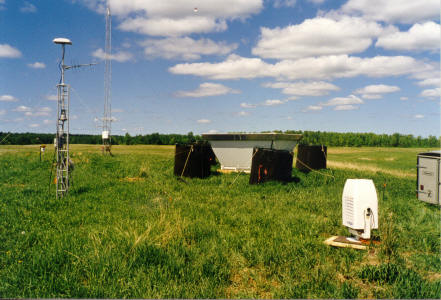Regional Forest-ABL Coupling: Influence on CO2 and Climate

Kenneth J. Davis
Department of Soil, Water, and Climate
University of Minnesota
1991 Upper Buford Circle
St. Paul, MN 55108-6028
U.S.A.
phone: +1 612 625 2774
fax: +1 612 625 2208
email: davis@soils.umn.edu
Major collaborators:
A. Scott Denning, Colorado State University (numerical modeling)
Dennis D. Baldocchi, U.California, Berkeley (Walker Branch data, micromet)
Jud Isebrands & Ron Teclaw, USDA Forest Service, Rhinelander (field support)
Peter S. Bakwin, NOAA/CMDL (WLEF observations, airborne profiling)
Vince Gutschick, New Mexico State (Chequamegon plant physiology)
Funding sources:
Terrestrial Ecosystems and Global Change program (TECO) through DoE.
National Science Foundation via the National Center for Atmospheric Research's Atmospheric Technology Division.
Duration:
September, 1997 through August, 2000
Project Summary
Radar/RASS measurements of boundary-layer developement will be conducted at two long-term flux tower sites, WLEF in Wisconsin, and Walker Branch in Oak Ridge. The goals are to observe the hypothesized rectifier effect which suggests that boundary-layer CO2 is enhanced over land compared to tropospheric values. If true, this effect has caused significant misinterpretation of the global CO2 distribution. A basic product will be seasonal-scale observations of the diurnal evolution of boundary layer development at each site.
The combination of direct, continuous flux divergence measurements at WLEF with continuous boundary layer depth monitoring provides a unique opportunity to study entrainment processes and plant-soil-cloud-ABL coupling. We will study the coupling between ABL development and net ecosystem exchange (NEE) of CO2. The plant-soil-atmosphere system is dynamically coupled, and these interactions must be observed to understand NEE of CO2. Boundary-layer growth and entrainment are often neglected in this system, but are critical to describing the couple land-atmosphere system. We will work at the WLEF tall-tower (March through October, 1998 and 1999), where flux divergence is observed directly, then attempt a similar study at Walker Branch (February through November, 1999), in an effort to extrapolate these methods to a small tower site, and see if this temperate ecosystem is substantially different from the WLEF region boreal forest. One dimensional coupled land-atmosphere models will complement the observational analyses. The 1998 and 1999 radar/RASS deployments are supported by the National Center for Atmospheric Research's Atmospheric Technology Division.